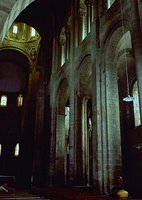 Prior to the development of Gothic cathedrals, the prevailing mode of construction was Romanesque, ie., in the form of Roman architecture, and the overwhelming things being constructed in this manner were churches. This was after all the Dark Ages, and Romanesque churches reflected that: dark interiors, few windows, little life in the proportions or rhythm of the building -- in short they were overwhelmingly gloomy, reflecting the overwhelming mood of the times (see left for example).
Prior to the development of Gothic cathedrals, the prevailing mode of construction was Romanesque, ie., in the form of Roman architecture, and the overwhelming things being constructed in this manner were churches. This was after all the Dark Ages, and Romanesque churches reflected that: dark interiors, few windows, little life in the proportions or rhythm of the building -- in short they were overwhelmingly gloomy, reflecting the overwhelming mood of the times (see left for example).
Yet after the turn of the millennia, a new mood was afoot. The year 1000 AD had passed and the world hadn't ended. The church still sucked the life out the peasantry, but more wealth and more intellectual inquiry were pursued. And a new, more optimistic conception of 'God's light of illumination' being at the heart of the town or city was formed (see for example Ulm Cathedral at right).
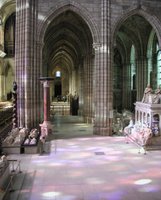 A new architecture was needed to express the new idea, but the prevailing Romanesque form was insuffiently supple to do it. The problem, you see, was the semi-circular or Roman arch, after which the style was named. Specifically, the semicircular arch couldn't easily transfer loads vertically to the ground without significant sideways buttressing -- the sideways thrust is significant with a semicircular arch or dome, as Michelangelo was to find later when he had to throw a chain around the base of St Peters dome to keep it intact -- and also with a semicircular arch the height and width of the arch are intextricably linked, which meant variation in floor plan was difficult to achieve. Taken together, these two features on their own meant the Roman arch itself, the very motif of the imperial Romanesgue style, was keeping churches low and gloomy, and stale and dull -- perfect for the Dark Ages but not so good for a more optimistic age. The Roman arch had to go.
A new architecture was needed to express the new idea, but the prevailing Romanesque form was insuffiently supple to do it. The problem, you see, was the semi-circular or Roman arch, after which the style was named. Specifically, the semicircular arch couldn't easily transfer loads vertically to the ground without significant sideways buttressing -- the sideways thrust is significant with a semicircular arch or dome, as Michelangelo was to find later when he had to throw a chain around the base of St Peters dome to keep it intact -- and also with a semicircular arch the height and width of the arch are intextricably linked, which meant variation in floor plan was difficult to achieve. Taken together, these two features on their own meant the Roman arch itself, the very motif of the imperial Romanesgue style, was keeping churches low and gloomy, and stale and dull -- perfect for the Dark Ages but not so good for a more optimistic age. The Roman arch had to go.Enter the 'pointed arch,' an Islamic innovation brought back from the Crusades and from journeys to Moorish Spain. The pointed arch solved both these problems at a stroke and was adopted wholesale, and with its adoption a new idea was able to be expressed.
You see, since the height of the arch no longer determined its width on the ground, the floor plan could become more supple and more lively. And since the pointed arch transferred loads more effiently and with a smaller sideways thrust, the buildings could become tall, really tall -- reaching to heaven you se
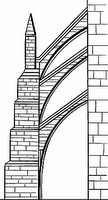 e, "linking the heavenly and earthly spheres" as Christian Norberg-Schulz puts it -- and the walls and buttressing could become ever thinner. And one more thing now entered, the invention of a Paris priest, Abbot Suger of St Denis: something called the flying buttress (left and below).
e, "linking the heavenly and earthly spheres" as Christian Norberg-Schulz puts it -- and the walls and buttressing could become ever thinner. And one more thing now entered, the invention of a Paris priest, Abbot Suger of St Denis: something called the flying buttress (left and below).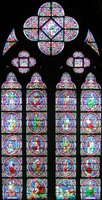
Rather like the stone scaffolding a spider would erect to support an outside wall if he were a great stonemason, Suger's flying buttresses took the load path away from the enclosing walls, allowing them to be even thinner, and held them aloft so the building could become even taller, and so thin that vast holes could be be punched through so 'God's glorious light' could flood in and overwhelm the supplicant within.
The effect was stunning and profound (see picture above at left of the St Denis interior), and the idea exploded around Europe -- with great spiders-webs of stone erected around ever higher and ever more glorious creations of man (see for example the choir of Reims cathedral at the bottom of the page).
To take the sideways thrust of these buttresses great piers were then erected, away from the outside walls and their vast stained glass windows, and on top of these piers enormous spires were then erected to counter-balance the sideways thrusts from the buttressing -- and with that the windows could be made much larger and the buildings even taller and ever more transparent!
 This was an exciting time to be a stonemason, with trial and error and much collapsing of stone producing ever taller and ever more transparent structures expressing the great idea of the age, such as it was.
This was an exciting time to be a stonemason, with trial and error and much collapsing of stone producing ever taller and ever more transparent structures expressing the great idea of the age, such as it was.Never was so much of mans' ingenuity used for so long in the service of such a shabby idea.
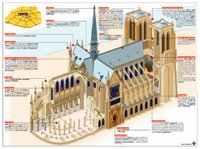
You can get some idea of the ingenuity involved in putting together Notre Dame of Paris, one of the smaller Gothic cathedrals, by clicking on and studying the cutaway picture at right.
The great idea of the Gothic cathedral was the expression of 'the age of faith,' of God's light illuminating man and the world, this idea itself being illuminated and expressed to an illiterate population through the means of architecture. The age of the Gothic Cathedral and the age of blind faith and illiteracy it represented was eventually killed by the printing press, and by the 'Age of Reason' that the printing press and the Renaissance beween them helped to bring about. As Victor Hugo put it in his famous essay on the demise of the Gothic cathedral in his novel Notre Dame de Paris, 'This Will Kill That,' an essay much admired by Frank Lloyd Wright and which expressed much the same idea as had Wright in the quote with which we began:
Human thought, in changing its form, was about to change its mode of expression; ... the dominant idea of each generation would no longer be written with the same matter, and in the same manner; ... the book of stone, so solid and so durable, was about to make way for the book of paper, more solid and still more durable. In this connection the archdeacon's vague formula had a second sense. It meant, "Printing will kill architecture." ...The great accident of an architect of genius may happen in the twentieth century, like that of Dante in the thirteenth. But architecture will no longer be the social art, the collective art, the dominating art. The grand poem, the grand edifice, the grand work of humanity will no longer be built: it will be printed.
And henceforth, if architecture should arise again accidentally, it will no longer be mistress. It will be subservient to the law of literature, which formerly received the law from it. In India, Vyasa is branching, strange, impenetrable as a pagoda. In Egyptian Orient, poetry has like the edifices, grandeur and tranquillity of line; in antique Greece, beauty, serenity, calm; in Christian Europe, the Catholic majesty, the popular naivete, the rich and luxuriant vegetation of an epoch of renewal. The Bible resembles the Pyramids; the Iliad, the Parthenon; Homer, Phidias. Dante in the thirteenth century is the last Romanesque church; Shakespeare in the sixteenth, the last Gothic cathedral.Thus, to sum up what we have hitherto said, in a fashion which is necessarily incomplete and mutilated, the human race has two books, two registers, two testaments: masonry and printing; the Bible of stone and the Bible of paper. No doubt, when one contemplates these two Bibles, laid so broadly open in the centuries, it is permissible to regret the visible majesty of the writing of granite, those gigantic alphabets formulated in colonnades, in pylons, in obelisks, those sorts of human mountains which cover the world and the past, from the pyramid to the bell tower, from Cheops to Strasburg. The past must be reread upon these pages of marble. This book, written by architecture, must be admired and perused incessantly; but the grandeur of the edifice which printing erects in its turn must not be denied.
 At least one architect of genius did appear in the twentieth-century who understood what Hugo meant, and he put it much more simply: "Architecture is the scientific art of making structure express ideas." Architecture may never again compete with literature for pre-eminence in the expression of ideas, but it behooves both the reader of literature and the student and practitioner of architecture to understand how architecture can and has expressed ideas in the past, and how it still does just occasionally.
At least one architect of genius did appear in the twentieth-century who understood what Hugo meant, and he put it much more simply: "Architecture is the scientific art of making structure express ideas." Architecture may never again compete with literature for pre-eminence in the expression of ideas, but it behooves both the reader of literature and the student and practitioner of architecture to understand how architecture can and has expressed ideas in the past, and how it still does just occasionally..
LINKS: The value of the pointed arch - Bryn Mawr College
This will kill that - Victor Hugo, Classic Reader
.
TAGS: History, Architecture, Building, Philosophy, Religion
3 comments:
Thank you for sharing your knowledge, Peter. That was fascinating; I now know around twice as much about architecture than I did before I started reading your piece, and know that I want to find out more.
Can you recommend any further reading? Preferably online, but dead trees will suffice :-)
Thanks Duncan. Here's a link to a reading list I put together last year for a prospective architecture student.
Thanks - I'll check it out.
Post a Comment